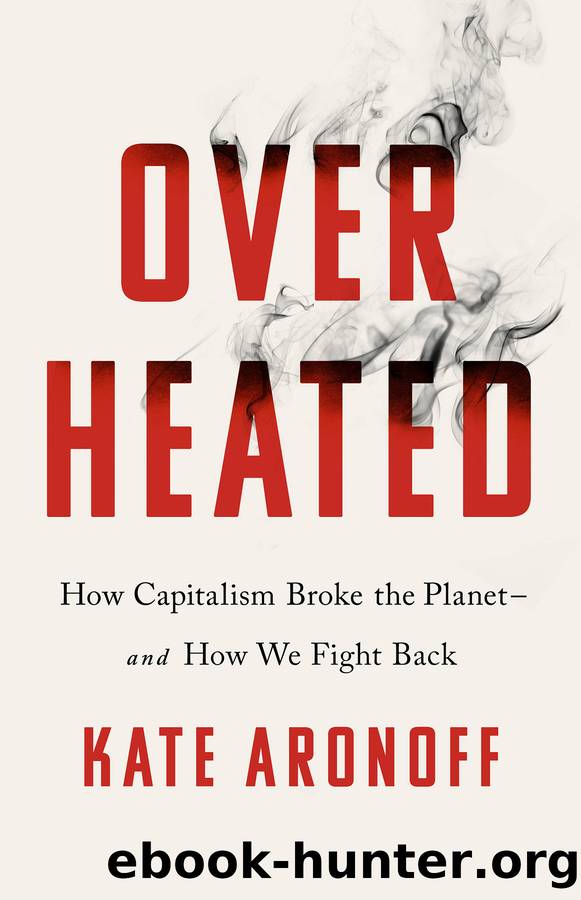Overheated by Kate Aronoff

Author:Kate Aronoff [Aronoff, Kate]
Language: eng
Format: epub
Published: 2021-04-20T00:00:00+00:00
THE NEW DEALâS public power programs were a microcosm of its larger contradictions. Black households enjoyed relatively few gains from rural electrification compared to their white counterparts. Landlords who rented to African Americans often chose not to pass power bill savings down to their tenants. The interests of Black tenant farmers in rural development programs were subsumed to those of white landowners, and African Americans were barred from the best-paid positions within the TVA and consigned to its most menial jobs. John Rankin, a Mississippi House member who pushed hard for the TVA and one of the countryâs most dogged advocates for public power, fought for rural electrification as doggedly as he fought against antilynching bills. Southern Democrats broadly supported the TVA for the benefits and job creation it would bring to a region long neglected by the utility giants. For all its transformation of life in the South and its built environment, the REA and TVAâlike much of the New Dealâself-consciously did nothing to disturb Jim Crow.
Their foundations in segregation extend well into the present. Many co-ops are still unrepresentative of the areas they serve. In southern states, many that serve majority Black service areas have for years maintained all-white co-op boards and employed majority white staffers and contractors; some co-ops havenât had proper elections in several decades. In the Black Belt, where the civil rights movement swept majority Black local governments into power, RECs continue to lag behind, often featuring little to no minority representation.
Nsombi Lambright is the executive of One Voice, an affiliate of Mississippiâs NAACP, which trains up African American co-op member-owners to run for boards on nine of the stateâs twelve co-ops, many of which serve majority African American counties. Lambright knew of only three Black board members in the co-ops theyâve been targeting. While Mississippi is 37 percent Black and nearly half its residents get their power from co-ops, its co-op boards are 91 percent white and 96 percent male. Rates can be well above whatâs offered in adjacent IOUs, with some co-op membersâmany of them living in persistent poverty countiesâpaying as much as 40 percent of their income on monthly bills. âThe only thing that has pretty much been common among the co-ops is that the members of the board tend to be the existing power structure in the community,â Lambright told me.
âWhat weâre dealing with here is that racism is still alive in America. These RECs were started in the 1930s and â40s. In Alabama at that time, there was no justice, no equal rights,â John Zippert, of Epes, Alabama, told me. With the Federation of Southern Cooperatives Land Assistance Fund (FSC)âa group supporting Black cooperative development in the rural South, founded in 1967âZippert, a civil rights movement veteran, has worked with member-owners of the Black Warrior Electric Membership Corporation to make it more democratic. While Zippert estimates that as much as 60 percent of Black Warriorâs 26,000-plus membership is Black, âup to this point,â he said, âthey have not had a Black board member.
Download
This site does not store any files on its server. We only index and link to content provided by other sites. Please contact the content providers to delete copyright contents if any and email us, we'll remove relevant links or contents immediately.
International Integration of the Brazilian Economy by Elias C. Grivoyannis(98353)
The Radium Girls by Kate Moore(11967)
Turbulence by E. J. Noyes(7977)
Nudge - Improving Decisions about Health, Wealth, and Happiness by Thaler Sunstein(7654)
The Black Swan by Nassim Nicholas Taleb(7054)
Rich Dad Poor Dad by Robert T. Kiyosaki(6506)
Pioneering Portfolio Management by David F. Swensen(6253)
Man-made Catastrophes and Risk Information Concealment by Dmitry Chernov & Didier Sornette(5951)
Zero to One by Peter Thiel(5728)
Secrecy World by Jake Bernstein(4698)
Millionaire: The Philanderer, Gambler, and Duelist Who Invented Modern Finance by Janet Gleeson(4417)
The Age of Surveillance Capitalism by Shoshana Zuboff(4242)
Skin in the Game by Nassim Nicholas Taleb(4200)
Bullshit Jobs by David Graeber(4136)
The Money Culture by Michael Lewis(4127)
Skin in the Game: Hidden Asymmetries in Daily Life by Nassim Nicholas Taleb(3960)
The Dhandho Investor by Mohnish Pabrai(3721)
The Wisdom of Finance by Mihir Desai(3691)
Blockchain Basics by Daniel Drescher(3533)
